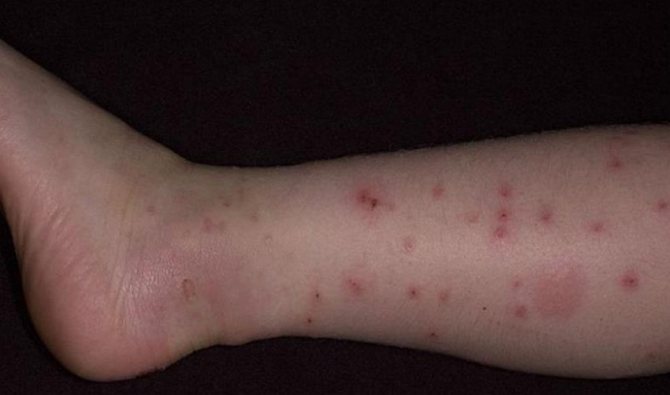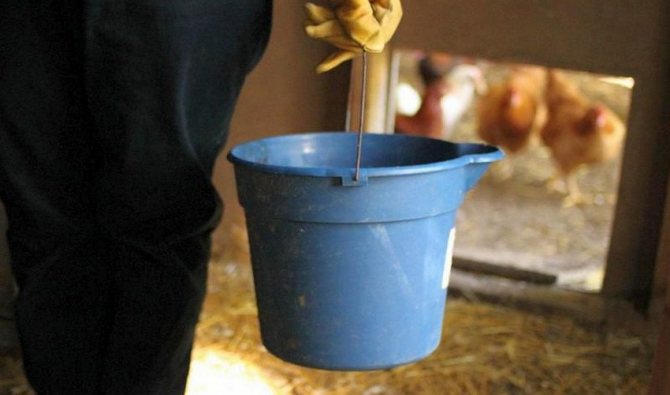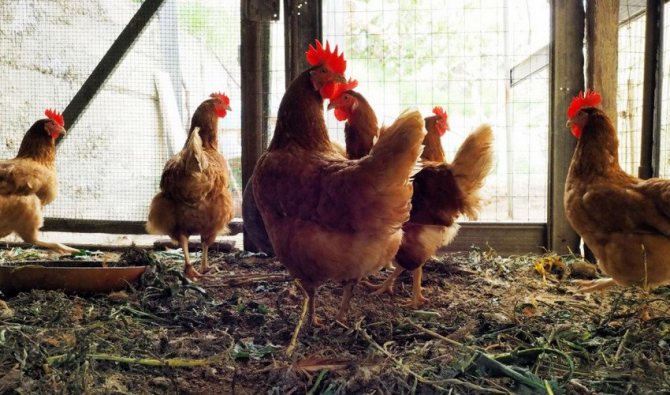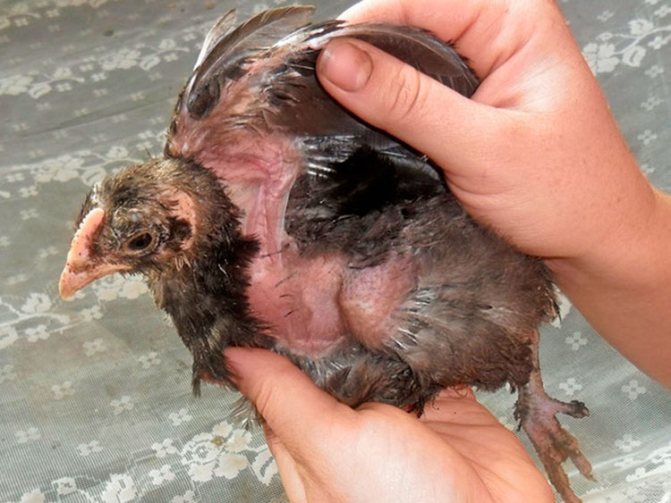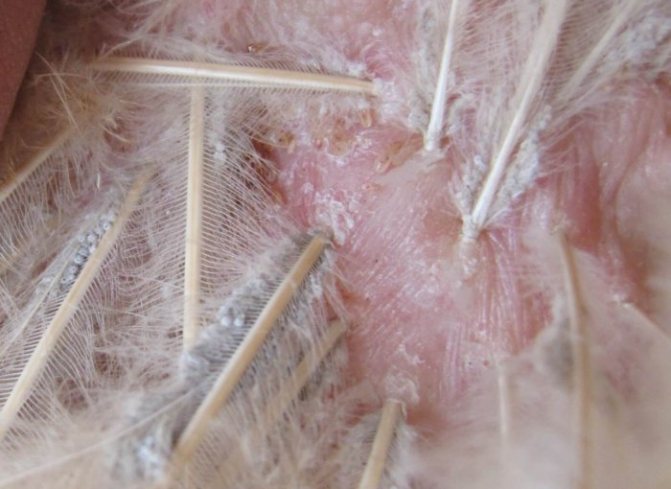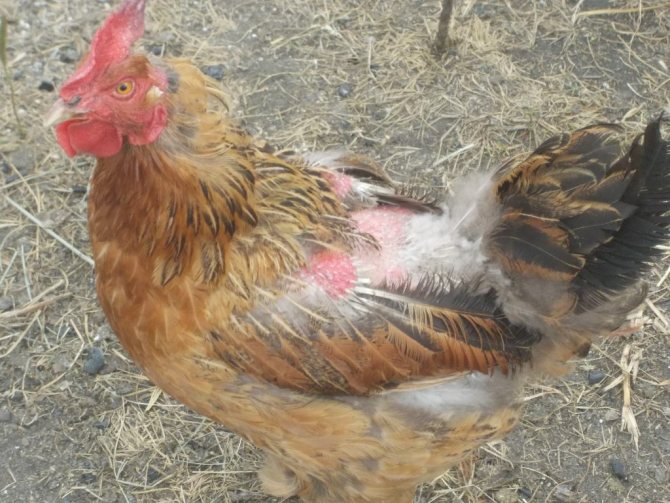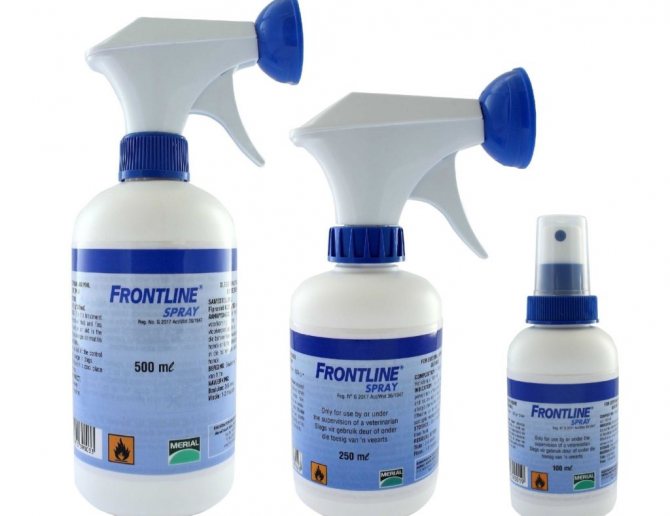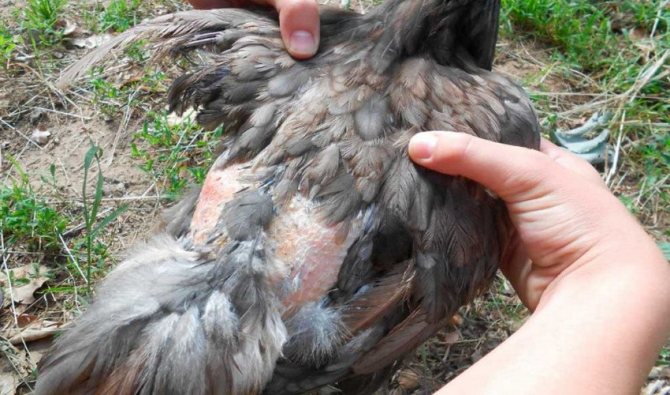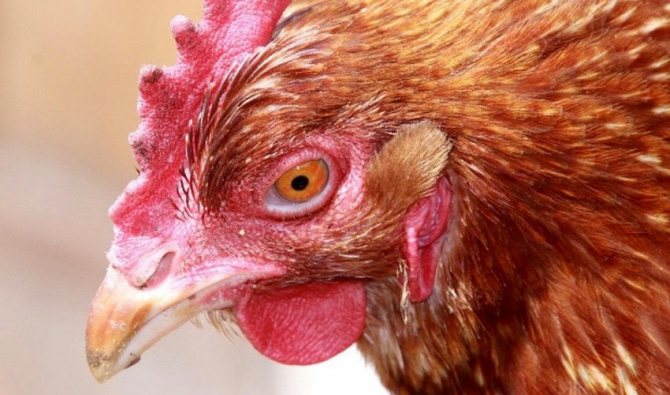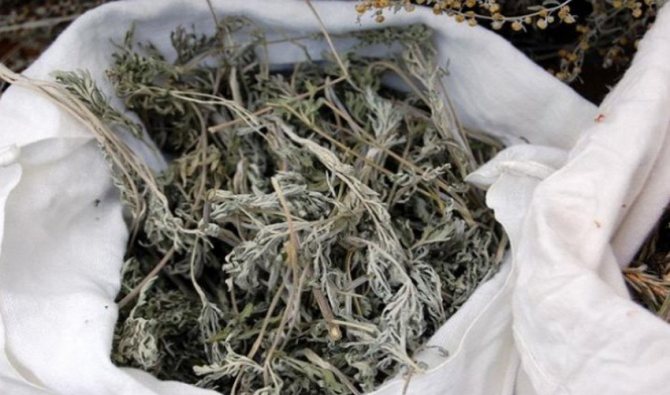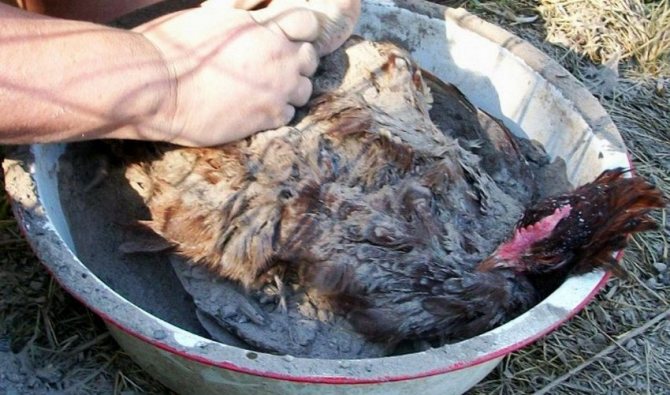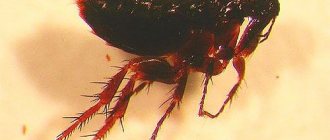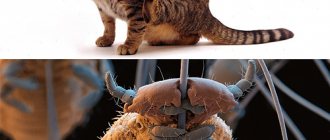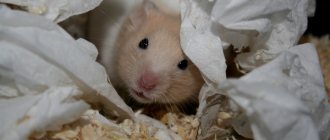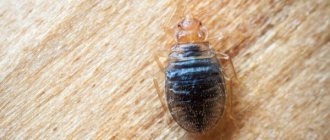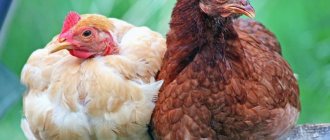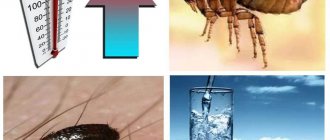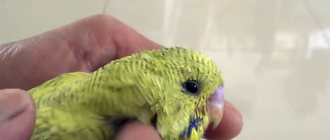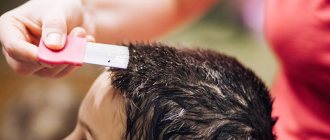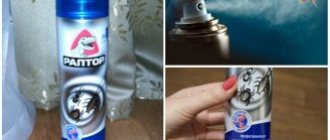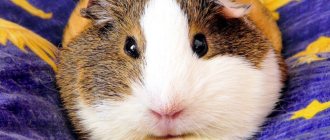Almost all rural residents are engaged in poultry farming. Chicken lice that appear can be a real problem, since the constant itching depletes the animal's nervous system. With prolonged exposure to parasites, the health of the poultry can deteriorate significantly, which will negatively affect the growth of young animals, the quality of meat, and egg production.
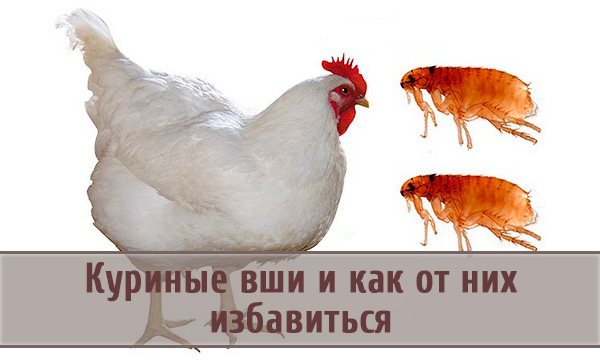
These insects, which are also called the feather-eater (lice), settle under the feathers of the chicken, provoking significant discomfort, itching, and rapid exhaustion. They are even capable of provoking death. But the main danger that lice carry is the spread of dangerous infections that can infect humans. So how to diagnose and remove such dangerous insects?
Chicken flea chemicals
The most effective insecticidal pesticides used in the destruction of pests:
- Insectoacaricidal powder;
- Butox;
- Promectin;
- Frontline;
- Beafar;
- Stomazan;
- Leopard;
- Not anointed.
The last two options are contraindicated in layers due to their increased toxicity.
Butox
The drug is widely in demand on poultry farms and large farms. It is produced in the form of a water-soluble liquid, packaged in ampoules, with a volume of 1 ml. The main active ingredient in the composition is deltamethrin.
For the treatment of birds, 1 portion is diluted in 4 liters of water. Apply to feather composition by spraying. To do this, take special spraying devices.
Deltamethrin powder
Another effective insecticidal composition, with the same range of capabilities as Butox. The product is toxic, so when working with it, it is necessary to observe safety measures: put on a respirator on your face so as not to inhale harmful vapors.
It is sold in the form of a powder, which is dissolved before use. Rubbed into the skin of a bird, spray feathers. The same solution is allowed to process the chicken coop.
Insecticides and veterinary drugs
Veterinary pharmacies sell special products for the treatment of malofagosis. They act selectively - they kill insects, affecting their nervous system, but do not harm the bird and do not accumulate in its body. This is the safest way to deal with parasites.
We list the drugs that have proven their effectiveness.
- Insectoacaricidal powder is available from many manufacturers. For example, Barrier powder. The action is almost the same. 1-5 g of the drug should be sprayed onto the chicken, rubbing lightly into the feathers.
- Beafar and Frontline are insecticidal sprays. Spray on the bird against the feathers until they get wet.
- INVESA Promectin oral solution. Designed for replacement chicks and broilers. They are drunk in the morning, adding "Promectin" to drinking water. Dosage - 1 mg is dissolved in ¼ of the daily water requirement per 25 kg of poultry (depending on weight - from 12 to 30 chickens).
- Spraying preparation "Butoks". It is necessary to prepare the solution at the rate of 2.5 ml of the drug per 10 liters of water. If there are few birds, an ampoule - 1 ml - is diluted in 4 liters of water.
For treatment (spraying), other insecticides can also be used, for example "Stomazan", "Neostomazan", 2% oxamate emulsion. However, these agents are more toxic to chickens, they cannot be used to treat layers and a month before the slaughter of poultry. Any treatment - with sprays, powder or liquid - must be repeated after 7-10 days in order to destroy the larvae that did not die during the first treatment. By this time, they have already turned into an adult and completely die during processing.


Prevention measures
We sincerely hope that the article on how to get rid of parasites was informative for you. Instead of a conclusion, we thought it necessary to give you some recommendatory advice on the prevention of skin parasites. It is much easier to prevent a problem than to waste energy on solving it.
- Try to protect the coop from rats and mice. These rodents are the main carriers of lice and fleas.
- Clean both the interior of the chicken coop and the surrounding area regularly.
- Visually inspect layers frequently. Infected individuals must be isolated from other birds.
- When buying a new hen, keep it in a separate room for some time. For the rest of the birds, a new one should be released only after preventive treatment.


"Title =" Watch Video: Bathing Chickens "data-pagespeed-url-hash =" 3980186416 ″ onload = "pagespeed.CriticalImages.checkImageForCriticality (this);">
Signs of skin parasites
If, for no apparent reason, the egg production of chickens has declined, it is quite possible that skin parasites have started in the hen house. It is very problematic to notice fleas and lice with a cursory visual examination. But there are pronounced signs of the presence of skin parasites in the chicken coop.
Birds show nervousness, often pick feathers with their beak or paws, and lay eggs poorly. A chicken suffering from lice or fleas will quickly lose weight. If in the chicken family, you begin to notice similar symptoms, then take the bird and see it better.
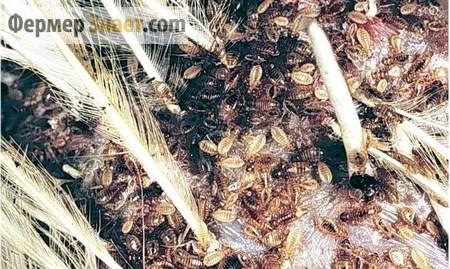

Ticks appear on exposed areas of the body, mainly on the legs. Lice and fleas prefer more secluded places and burrow into bird feathers. If the feathers of an infected chicken are fluffed, then dark spots, similar to moles, become noticeable. This is chicken lice. Sometimes the abundance of these parasites can literally be terrifying.
It is necessary to get rid of lice as soon as possible. The fact is that they lay eggs in the feathers of birds and breed. Therefore, the number of parasites in the chicken coop is growing exponentially.
In order to guaranteed to get rid of bedbugs, lice and fleas, it is not enough to use preparations for chickens, you need a complete sanitization of the chicken coop!
Treatment of chickens from parasites
If the chickens itch, what to do needs to be decided immediately. Remember that the situation is rapidly deteriorating. That is why it is necessary to find a suitable method for eliminating fleas.
Folk remedies
Folk remedies for treating a chicken coop from fleas of chewing lice are the use of a solution of vinegar and diluted kerosene
It is necessary to use such drugs with extreme caution, because they can harm delicate skin.
To treat chickens with kerosene, you need to mix the product with ammonia. Apply the drug only to the withers area. This treatment is carried out twice, the break between procedures should be a week. All surfaces in the hen house are treated with the same solution so that the pungent smell of the products scares off the parasites.
Eucalyptus and rosemary essential oils have an effective effect. They need to lubricate the walls of the room in which the chickens live.
An alternative to the above remedies can be a solution based on 6% vinegar. The product must be dissolved in one and a half liters of water.After that, it is sprayed onto the feathers of the bird, capturing its entire body. The procedure is carried out twice, between the processing of chickens you need to take a break of a week.
Our great-grandmothers also fought with lice that were in the chicken coop, dust and sulfur. The drugs are poisonous, so you can spray them in the room if there are no birds in it. You can also hang dried fragrant herbs in the coop so that their smell scares away parasites.
You can also highlight such effective folk methods:
- chamomile infusion: rub this safe product into the feathers of the individuals, repeating the operation daily until the parasites are completely gone;
- wormwood powder: prepared from various parts of the plant, the powder can be used with chamomile infusion to speed up the desired results;
- sand and ash baths: it is imperative to place several containers filled with such materials in the hen house so that the bird can swim, removing parasites from the body on its own.
Consider the advice on how to treat fleas and lice in chickens without harming their health. Traditional methods are always effective, but if they did not help, you will have to move on to more radical methods that give faster results.
Chemicals
There are special chemicals to combat chewing lice. Among the most popular options are:
- Karbofos - the product combines optimal properties, so it is often used not only for processing poultry, but also for the room in which it is located;
- Delcid is an effective remedy that allows you to quickly deal with fleas and lice in chickens;
- Celandine, Insectol, Bars - sprays that are sprayed directly onto the skin of the chicken to destroy parasites without unnecessary complications;
- The Front Line is a droplet that will prevent infected layers from infecting healthy flocks with lice.
To avoid poisoning of chickens during the processing of livestock from chewing lice, it is worth tying the bird's beak. Experts say that the procedure carried out in accordance with all the rules makes it possible to destroy adults and larvae in a few minutes. But you need to process the chicken again after two weeks, since the eggs of the parasites can survive, so the trouble will come back again.
Symptoms of infection in chickens
Bird lice do not bite through the skin, but cause itching by their movements in the depths of the feathers. As a result, the chickens are worried, trying to get rid of scabies by pulling out a feather on themselves. Often the bird pecks at itself in the blood. A secondary infection "sits" on open wounds, and the skin on the exposed areas becomes inflamed. Reduces the resistance of chickens to other diseases. Exhaustion is observed. Young growth lags behind. The hens stop laying eggs.
On a note!
The diagnosis can be made visually by catching the chicken and spreading the feathers. Feather lice are large enough insects to be seen with the naked eye. The length of the lice can be from 1.5 to 2.5 mm.
The second way to diagnose infestation is to collect insects from the chicken skin with a damp brush and examine under a magnifying glass. After establishing the diagnosis, you can decide what to do if the chickens have lice - whether to slaughter or treat.
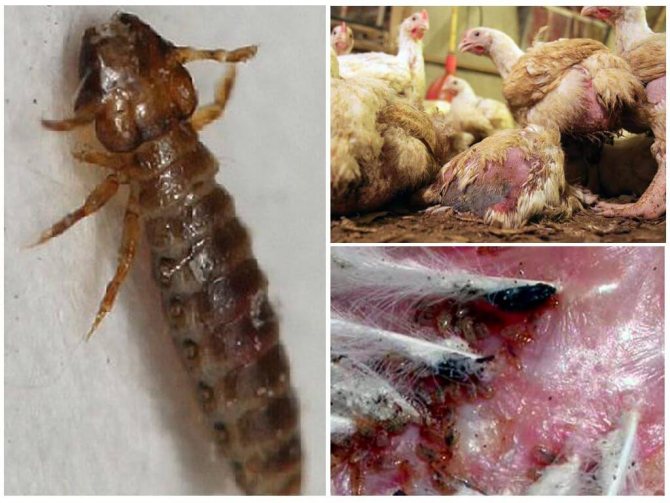

Pooferoids in chickens
Can a person get infected with chicken lice?
Puff lice and feather eaters can get to a person and even bite him. But the human body is not a suitable environment for insects that parasitize birds. If lice even get into the scalp, then simply washing your head with shampoo can get rid of them. That is, when processing birds, there is no need to fear that the parasites will "migrate" to a new host - a man.
But nevertheless, it is impossible to say that chicken lice are absolutely harmless to humans. Walking around an infected bird with exposed parts of the body can lead to multiple bites and infection with various diseases.We must not forget that blood-sucking parasites are carriers of infections. Even without becoming a "house" for parasites, you can get seriously ill.
Poultry staff's clothing can provide temporary shelter for lice. Thus, a person transfers them from sick to healthy chickens. Some species can live without food for a long time, therefore, in case of detection of parasites, it is necessary to process the personnel's clothing.
Signs of chicken lice
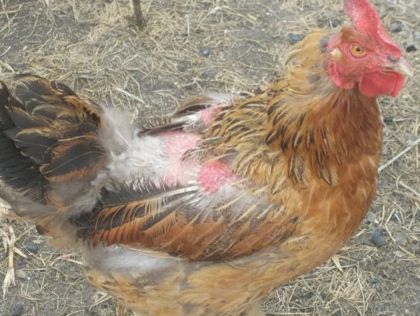

How to determine the infection with chicken head lice? Basically, this manifests itself in an already advanced stage. During this period, you can consider individual individuals that move along the head and feathers of the bird. Lice do not like bright light, so they try to hide under the wing or by the tail of birds.
Close observation of a walking bird will also help detect disease. Mass infection, with daily blood loss, is reflected in the birds. The bird becomes lethargic, inactive, the ridges become bluish, anemia develops. Attention should be paid to the frequent fingering of their feathers by the bird; in the process of cleaning, chickens pluck out their feathers. Roosters, due to the rare cleaning of their feathers and their dislike for dust baths, have a greater number of parasites on their bodies.
Despite the fact that humans and other warm-blooded animals can carry chicken lice, parasites cannot live on organisms other than poultry. This is due to a thicker skin, lice cannot bite through it, which means they will die of hunger. Having accidentally hit the human body, the parasite will eventually die. Consequently, chicken lice cannot live either on a person or in an apartment, due to lack of nutrition.
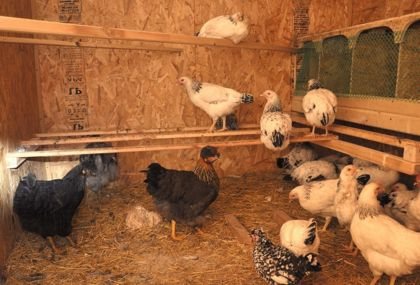

Lice can infect people with dangerous diseases. They spread influenza, adenovirus infections, spirochetosis, reoviruses and other types of diseases. Human infection can occur from the use of a sick bird. For example, not fried chicken meat, can also become a source of infection, visiting a chicken coop, requires compliance with hygiene rules, otherwise infection cannot be avoided.
The main methods of treatment
The main question at the first manifestations of the symptoms of parasites is how to get rid of them. Immediately after detecting the signs of fleas, as shown in the photo, you need to start solving this problem.
Important! You need to get rid of parasites meticulously, treating all birds very well. It is important that all individuals are processed and disinfected.
Veterinarians offer two methods of treatment: chemical and folk - which should be started immediately.
Traditional way
It is most effective to fight parasites in the traditional way or with chemicals. For chickens, anti-flea drugs are harmless, but lice, affecting the nervous system, are killed. What means of flea control are used:
- Drops for chickens, like "Neo", "Bars" and others.
- Sprays for chickens, and sometimes aerosols for humans are also used. This is done only as indicated by a specialist, strictly following the instructions. For example: "Get", "Nyuda" and others.
- Liquid for room treatment, the most common "Carbophosis". To eliminate parasites, it is imperative to process the floor, walls and perches of the chicken coop.
All known drugs work only on adult lice, but after about 1-2 weeks they will hatch again from the eggs. Therefore, it is necessary to re-fight the bloodsuckers in 7-10 days.
Attention! Before using any medication, you must read the instructions and consult a specialist. The application should take place according to all the rules and indications.
Folk methods
Owners of chickens faced the problem of lice even before drugs were available. They used various folk remedies.
The most effective folk methods for removing chicken fleas:
- Use deterrent scents such as tansy and rosemary branches, chamomile flowers, and rosemary and eucalyptus essential oils.
- Treat the birds with vinegar diluted in half with water. The most effective will be a combination of vinegar and kerosene in a 1: 1 ratio.
- An excellent remedy is a mixture of kerosene, ammonia and benzene in equal proportions. This mixture is applied not only to chickens, but also to process their home.
Chickens are usually bred in the village, so folk remedies to remove fleas are at hand. Traditional methods of dealing with them are more costly, for which you often have to go to the city.
What means cannot be used?
There are remedies that are effective against chicken lice, but harmful to the bird itself. Some drugs may not harm the chicken, but build up in the meat. Through meat, they enter the human body, causing intoxication. For example, chlorinated carbohydrate products accumulate in both meat and poultry eggs. Therefore, there are a number of drugs that are prohibited to combat parasites:
When using approved insecticides, it is important to observe their dosage. Exceeding it also leads to the accumulation of the drug in chicken meat and eggs.
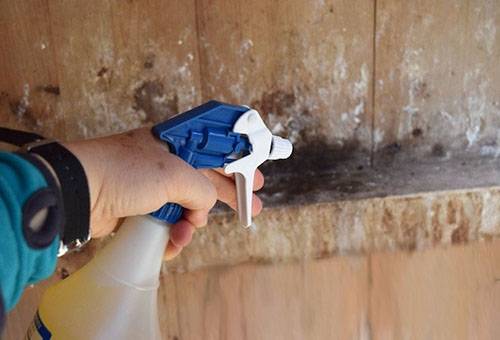

Why are they dangerous?
Many owners believe that fleas in chickens are not an important disease and do not require treatment. However, this is a big misconception, the appearance of parasites leads to serious consequences. What harm can chicken lice do:
- they can become carriers of infectious diseases;
- can also infect a bird with helminths;
- due to itching and uncomfortable sensations can lead to weight loss and death;
- with prolonged contact with parasites, chickens experience problems with the number of eggs, as well as deterioration in health.
Symptoms of the appearance of parasites
The infected bird must be seen by a veterinarian who can diagnose and treat the bird. In the photo below you can see chicken fleas.
What signs does a chicken show in the presence of blood-sucking parasites:
- she becomes nervous and restless;
- bites itself with its beak or pulls out feathers;
- partial baldness of feathers or down;
- decrease in weight and performance, and sometimes appetite;
- mortality of chickens and young hens.
If at least one symptom is found, it is necessary to examine all the chickens and separate the exactly infected ones, although, most likely, they are all already. Then, urgently start to deal with the problem that has arisen.
Control methods
It is impossible to allow the spread of fleas among the chicken population, because it is impossible to expect high egg production and an increase in live weight from sick individuals. Monitoring the livestock, examining suspicious individuals, maintaining hygiene in the chicken coop and timely treatment of diseased birds are the only means of combating this disease.
At the onset of the disease, fleas in chickens are poorly visible due to their small size.
Therefore, during inspections, it is necessary to pay attention not only to those places where parasites like to be most of all: on the head and legs, but to carefully sort out the feathers on the bird's body. If parasites are found in at least several heads of chickens, it is necessary to immediately treat the entire livestock and disinfect the chicken coop and equipment
The poultry farmer must know how to deal with chicken fleas, and most importantly, how to do it correctly.
Birds can be quickly cured with the help of veterinary insecticidal preparations designed to destroy parasitic insects, as well as combine them with folk remedies.
Poultry processing
To remove fleas from chickens on small home farms, where there are not very many birds, you can use special drops designed for cats and dogs. They are sold at pet stores or veterinary pharmacies all over the place. The choice of funds is wide enough. Among the well-known and effective ones are:
- Leopard;
- Stronghold;
- Advantage;
- Dana;
- Frontline.
They use drugs for the treatment of chickens, calculating the dose according to the instructions.The products are applied in the same way as for cats and dogs - the solution is dripped onto the skin of the neck behind the head so that the chickens cannot be poisoned by the liquid. After 0, 5 - 1 days, the fleas die. Severely infected birds are re-treated. When used correctly, this chicken flea remedy is safe and does not cause side effects.
In large farms, where the number of livestock is in the hundreds, fleas can be removed from chickens using powders and ampoules with solutions of synthetic pyrethroids (insecticides that have a nerve effect on insects). Such means give a good result:
- Butox (oily liquid in ampoules based on deltamethrin). In order to destroy chicken parasites, dilute the contents of 1 ampoule (1 ml) in 4 liters of water. Poured into a special sprayer and applied to the plumage of each chicken.
- Deltamethrin powder. Powder is sprinkled on infected birds, excluding the head. For better action, the drug is lightly rubbed into the skin.
When using insecticides in the form of liquid and powder, care must be taken not to get them in the eyes, nose and mouth. You need to work in a respirator and rubber gloves.
If there are few fleas, folk methods of fighting parasites will help. Scatter small twigs of wormwood or juniper around the room. Insects cannot stand their smell.
Or place containers with ash so that the birds can swim in it, thereby cleaning themselves of fleas on their own.
Disinsection of the premises
Complete treatment of the room where the sick bird lived helps to completely get rid of fleas in chickens. Before starting disinfection, you need to clean the chicken coop well, remove the dirty litter and droppings. This will remove some of the eggs and pupae immediately. Everything collected must be burned.
You can treat the chicken coop with an insecticide in capsules or a concentrate designed to kill fleas, bugs and cockroaches in living quarters. Take advantage of:
- Tsifox;
- Karbofos;
- Tetrix;
- Cucarachei;
- Butox;
- Deltamethrin, etc.
Household insecticide aerosols in cans (Reid, Raptor or Combat) also give a good effect.
To disinfect the chicken coop, first remove all livestock from it, then prepare an insecticide and spray or sprinkle powder on the perches, cages, nests, feeders and the floor. Leave the room closed for several days. Then ventilate it and lay a new litter. They return the chickens to their place. After 2 or 3 weeks, another disinfection is carried out in order to guarantee the kill of all parasites that did not die during the first treatment and during this time managed to turn from pupae into adults.
Chicken coop processing
The algorithm of actions is simple, but it must be strictly followed:
- Move the bird out of the room.
- Pre-remove accumulated dirt in the chicken coop.
- Run a gas torch or blowtorch over all fire-resistant surfaces. Everything else is treated with insecticides: 0.5% karbofos solution; 10% suspension of pyrethrum or dilute butox, neostomazan in proportions 1: 200.
- Withstand the room for several hours, and ideally 1-2 days.
- Change the litter, wash everything thoroughly (drinkers, feeders) and remove.
Description of the pest
Appearance
The chicken parasite looks very similar to dog or cat fleas. Although biologically these are different species. The body of this pest, unlike other species, is flattened on two sides, divided into three parts: a head with two eyes and a pair of antennae, a thoracic region, where three pairs of legs are located, and a large abdomen. Usually the insect is brown or black, depending on the species. The body is covered with a dense chitinous cover, on the surface of the cover there are irregularities and hairs, with the help of which the flea is fixed on the feathers. The oral apparatus has a piercing-sucking structure.The back pair of legs is strongly developed, which allows fleas to push off and jump over great distances, so the insect can jump up to 1.5 m in length.
Varieties of chicken fleas
In total, there are more than 2 thousand different species of fleas. There are mainly two species inhabiting domestic birds.
- Chicken flea. Slightly larger than a black flea, it reaches a length of 2-2.5 mm. The body is brown. The most common flea species on poultry. Can attack humans and animals. It is believed that initially the pest appeared on titmouse, and only then settled on poultry. Unlike other species, it does not need blood feeding before mating.
- The flea is black. In length reaches 1.5 mm, the body is black. Most often it lives in excrement. Able to bite mammals and humans.
Breeding and lifestyle features
These parasites are quite thermophilic, the temperature of about 40 degrees is the most comfortable for them. Exactly what temperature is maintained under the feathers of chickens, allowing insects to live and reproduce in comfort. Also, high humidity, lack of ventilation, accumulation of dirt and debris can be attributed to good conditions for the development of parasites. Fleas feed on the victim's blood, choosing areas of the body where the skin is especially thin, and the vessels are located close to the skin. These parasites, unlike ticks, do not inject an anesthetic into the bloodstream, so their bites are very painful, because of this, insects are very annoying to poultry.
Chicken flea
The female lays eggs daily, pushing them out of the abdomen while jumping. Thanks to this, the eggs are scattered throughout the chicken coop. Especially a lot of them accumulate in the nests. In this way, the female can lay up to 40 eggs per day. Eggs are microscopic white oval grains. After about a week, worm-like larvae hatch from the eggs. They live mainly in nests and bedding, feeding on excrement, bird food debris, and skin particles. The larvae are afraid of light, so they hide in dark secluded places. Thus, the larvae exist for 7-10 days, then they entangle themselves with cobwebs, turning into a pupa. The pests are in the pupa state until they find a suitable prey for themselves. This stage can last up to several months. Once on the victim, the pupa turns into an imago. In the adult stage, the insect lives from 2 to 12 months.
Life cycle and behavioral features
Unlike other species of fleas, chickens are not able to live long outside the body of the victim. That is why the parasites strive to settle down as much as possible in the selected territory, without the possibility of further migration. They can settle near chickens, for example, under bedding.
Insects are dependent on the temperature regime of their habitat. Able to endure short-term discomfort while jumping to another object. For a long stay, a person is not suitable for them, since the temperature is lower and the epidermis is thicker (unable to bite).
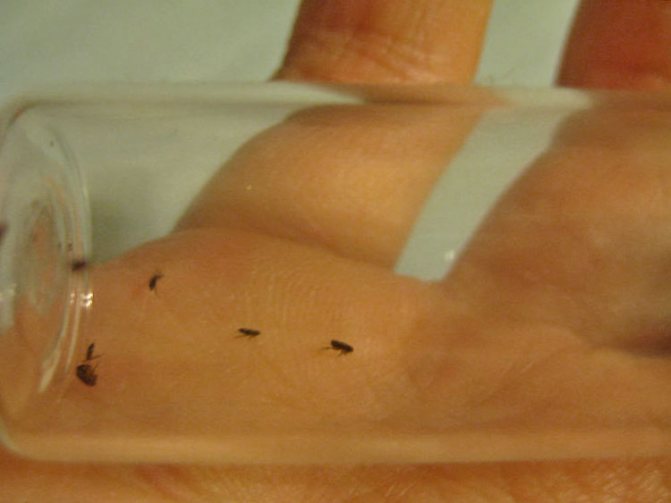

In a hen house, flea breeding is possible if:
- Sanitary standards are not supported: there is no ventilation, it is dirty, bedding does not change for a long time.
- High humidity and temperature in the room.
- There is no scheduled disinfection.
Getting into such a favorable environment, they multiply intensively in a few days. Females leave egg clutches daily, while scattering them on the sides with their hind legs. Thus, they seek to expand the settlement zone. As a result, the chicken coop is littered with white microscopic capsules. Of these, larvae soon hatch, quickly turning into adults.
The life cycle of a flea is about a year.
How to determine if a chicken has fleas
How to determine if a chicken has fleas
With a mild infection, symptoms may appear less severe.
Any unexplained drop in production or increased feed intake should be suggestive of the possible presence of external parasites in birds.
Lice and northern chicken mites can be detected simply by touching feathers. But in order to see these small parasites, you need bright lighting and good vision. Adequate illumination can be obtained with a light attached to the head with a special elastic bandage.
To control infected birds in production flocks, it is necessary to select 20-50 heads at least twice a month. In this case, the selection must be made randomly and from all parts of the room. In the birds being tested, the head, legs and anus should be carefully examined.
If the found parasite cannot be immediately identified, then it can be sent either to a laboratory or to an entomologist. Blood-sucking parasites (bed bugs and chicken mites) that attack birds only for food are more difficult to spot.
Attention! Check perches, walls, crevices and all other places where they might hide, as well as places under piles of droppings. At the same time, a pointed probe may be useful for detecting parasites in cracks in a tree. Nest material, dust and other materials that accumulate in the room can be decomposed in a white bath for testing.
To detect parasites that feed at night, it is necessary to carry out night checks on birds. Posthumous examination in the laboratory is necessary to identify internal organs
Nest material, dust and other materials that accumulate in the room can be spread out in a white bath for testing. To detect parasites that feed at night, it is necessary to carry out night checks on birds. Posthumous examination in a laboratory is necessary to identify internal organs.
Chicken fleas - what is
Fleas (order Siphonaptera) parasitize in adulthood, but live freely in the larval stage. Adults are about 1.5 mm in size. They have a rigid, laterally compressed body, a piercing-sucking mouth, short antennae in the notch and long legs adapted for jumping.
Their transformation cycle is complete. At the larval stage, they have no legs, they look like a caterpillar, and the pupa is in a miniature cocoon. Fleas range in color from brown to black and feed on blood from a variety of host species.
A fully grown larva weaves a silk cocoon, entangling various particles of dust and dirt with threads. Depending on the temperature, the immobile stage of the pupa lasts from one week to several months.
Coming out of pupal cocoons, young fleas look for a host, suck blood from him, and after a few days become sexually mature. Immature fleas can live without food for weeks or months. Adults can live without food for several weeks, but if there are hosts, they can live from several months to a year.
Sucking flea
Adults usually attach to the scalp, often in groups of a hundred or more. Their mouth organs penetrate deep into the skin, making these parasites difficult to remove. Sucking fleas are unique among poultry fleas.
Advice! In adulthood, they become sedentary and usually attach to the host's skin for days or weeks. Adult females lay eggs in litter (Fig. Sucking flea Echidnophaga gallinacea).
European chicken flea
Its owners can be chickens, pigeons, azure birds, sparrows and tree swallows, as well as humans, dogs, chipmunks, rats and squirrels. This flea stays on the birds for as long as it needs to feed. At the same time, its immature stages can be found both in nests and near them (Fig. European chicken flea Ceratophyllusgallinae).
Control.The most effective control measures for these parasites are the removal of infected litter and thorough spraying of the premises to kill flea larvae. After filling the house with fresh bedding, the birds and bedding must also be treated as parasites can fall into it from the treated birds.
In Scotland, pyrethroid pyrethrin is used as a 0.125-0.25% spray solution to control the European chicken flea (Ceratophyllus gallinae) in litter and perches.
Poultry, dogs, cats and rats should not be allowed to enter, as in this case they will constantly replenish the flea colony. Flea breeding is prevented by sunlight, warm dry weather, high humidity and cold.
Getting rid of fleas: a comprehensive approach
Getting rid of insects completely is very difficult. Much depends on the degree of parasite infestation of the bird. The procedure includes three components:
- pest control of the room in which chickens are kept;
- treatment of birds with anti-flea agents;
- taking preventive measures to prevent re-infection.
Disinsection of the chicken coop and processing of the poultry should take place in parallel.
Chicken coop processing
To get rid of chicken fleas in the chicken coop, you need to treat insecticide solution all surfaces, including perches, feeders and nests. After finishing the treatment, you should wait a few hours.
It is important to remember that cleaning the premises must be carried out after the completion of the pest control process. Old bedding and debris must be removed or incinerated. The treated room - rinse with water, if possible, treat the walls with lime.
Non-flammable surfaces can be burned with a blowtorch. It should be borne in mind that it will take a long time to deal with pests - it is advisable to carry out a second pest control procedure in 2-3 weeks (insects at the pupal stage are less susceptible to poison and can survive).
For the treatment of chicken coops use:
- chemical preparations based on chlorophos, karbofos, organochlorine compounds, etc. These are extremely effective agents, but very toxic and can harm chickens. Before use, the bird should be transferred to another room;
- synthetic pyrethroids, which, acting on the central nervous system of insects, cause their paralysis and death. You can carry out processing without removing the birds from the room, but you should refrain from eating their eggs and meat for several days;
- natural pyrethroids (solutions of Dalmatian chamomile, mixtures of wormwood and tansy) are safer for birds and humans, but less effective. A plus of natural remedies is the ability to prepare them at home.
You can populate a cleaned chicken coop after airing.
Individual bird handling
In parallel with the pest control of the chicken coop, it is necessary destroy pests directly on the bird... This is the most difficult and critical part of the pest control procedure.
There are several ways:
- application of special drops ("Feverfew", "Sevin", etc.) on the back of the bird's head;
- bathing and spraying feathers (solutions of Butoks 50, Aversect, etc.);
- treatment of chickens with a brush or cotton swabs with powders (deltamethrin powder, dry "Pyrethrum") - it is necessary to ensure that the drug does not get on the mucous membranes and in the eyes of the bird.
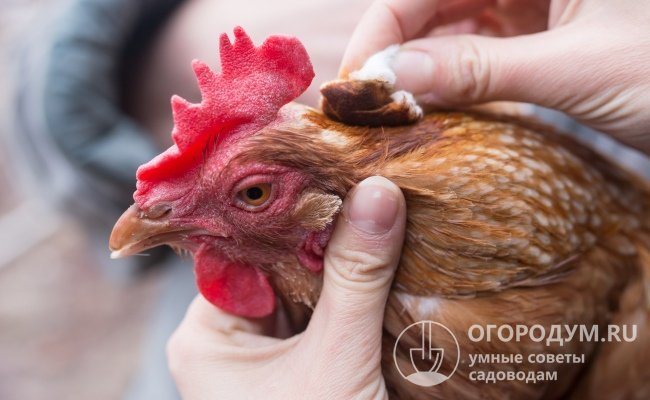

Flea control should be applied to the withers of the bird and rubbed gently and thoroughly into the skin with a cotton swab (as shown in the photo)
When applying, it is required to strictly adhere to the instructions attached to the preparations so as not to harm the poultry.
Application of birch tar
Birch tar is a kind of our national brand. On the farm of a Russian peasant, this substance has been used for centuries for medicinal, veterinary and many other purposes.Until the beginning of the 20th century, tar was produced annually in large quantities, was one of the most important articles of domestic export, and was highly valued in Western Europe.
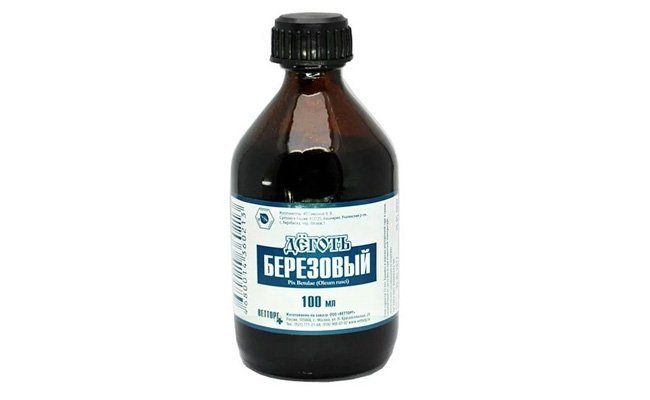

Today, birch tar is a common pharmaceutical preparation, which summer residents who want to receive environmentally friendly products are successfully used in the field of animal husbandry and poultry farming, as well as when caring for their garden plots.
Birch tar is oily, thick liquid of dark brown or black color with a strong characteristic odor... The product is completely natural. It is made by dry distillation of birch bark taken from young birch trees. Tar is harmless to people, pets and birds, not only when applied externally: ingestion of it in food does not pose any danger to health. In medicine, the agent is used to treat skin diseases, it is part of some pharmaceutical preparations (for example, balsamic liniment according to Vishnevsky), as well as perfumery and cosmetic products (tar soap, shampoos and creams).
The popularity of birch tar is due to the following properties:
- extremely high antibacterial and antiseptic activity;
- the ability to quickly and effectively destroy or scare away many parasitic insects and pests of horticultural crops;
- the possibility of using for the healing of minor skin lesions resulting from injuries or bites of blood-sucking parasites;
- ease of use;
- availability and relative cheapness.
The drug is perfect for getting rid of poultry from fleas, ticks, feather lice and other insects that cause damage to the skin or plumage. In addition, tar is widely used in veterinary medicine (as an internal and external agent): it is used to treat horses, cows, sheep, goats and pigs for a variety of ailments, from skin and hoof lesions to diseases of the digestive system and respiratory tract.
In chickens infected with fleas, birch tar is thoroughly smeared with skin areas bitten by parasites, as well as pecked and combed due to severe itching... Already after the first procedure, the number of fleas hiding in the plumage decreases sharply, since insects cannot tolerate the resinous smell of the drug. The tool has a pronounced wound healing effect, relieves itching and pain. Therefore, the wounds on the skin of birds quickly heal, the upper layer of the epidermis rapidly regenerates.
To cleanse the bloodsuckers chicken coop, carry out the procedure for fumigating the room. Step by step it looks like this (the consumption of materials is given for processing a room with an area of up to 50 sq. M.):
- 100 ml of birch tar is mixed with 800 ml of dry sawdust and left for 1 hour to thoroughly soak;
- a wide vessel (for example, a basin) with a volume of 4-5 liters is filled with charcoal (you can take a purchased one, which is intended for cooking kebabs). The coal is ignited and brought to a state of slow smoldering;
- the bird is removed from the hen house, the windows are tightly closed;
- a basin of charcoal is placed on the floor in the chicken coop. Sawdust impregnated with tar is spread over the coals in an even layer;
- when smoke comes out, the door is closed from the outside. The smoking device is left in the room until the coals are completely burned out (this usually takes 3 to 4 hours);
- after the end of smoking, the chicken coop should remain closed for another hour. Then you need to open the door and windows, and ventilate the room until the smell of smoke disappears completely.
In a chicken coop treated in this way, fleas and other bloodsuckers, as a rule, do not appear within six months. The effect can be further enhanced by hanging several small open bubbles with birch tar in places inaccessible to the bird (for example, under the ceiling). The smell of the product will be constantly present in the room, scaring away not only skin parasites, but also flies, mosquitoes and other flying insects.
Using birch tar to rid poultry of parasites is effective and safe, and with a small population it is not difficult at all. This is confirmed by the personal experience of many generations of domestic summer residents.
Preventive measures
The success of pest control depends largely on how regularly and efficiently preventive measures are taken to prevent re-infection.
Prevention of chicken fleas involves the following procedures:
- regular cleaning of the premises from droppings, feed residues, old sawdust or straw;
- adding twigs of wormwood, yarrow, tansy, geranium, lavender and other plants with a pungent smell to the new litter. In winter, you can use mint, lavender, eucalyptus oils;
- protection against contact with wild birds;
- periodic visual inspection of chickens (it is better to look through a magnifying glass).
Before carrying a newly acquired bird into the house, it is necessary to keep it in quarantine for several days. A container with a mixture of fine sand and ash (1: 1) with a layer of 20 cm should be placed within the reach of chickens so that the chickens have the opportunity to "bathe" in it. Chickens roll in ash, its smallest particles clog the respiratory organs of fleas, and grains of sand, when shaken, knock insects to the ground.
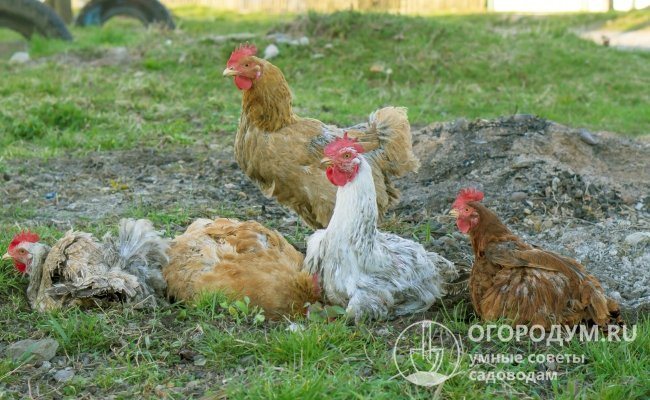

Ash is one of the most effective folk remedies for removing fleas from poultry
If fleas are found in poultry, do not panic. There are many inexpensive and effective pest control products available. Success will be guaranteed with the implementation of a set of measures. However, it should be remembered that prevention is a much cheaper and easier way to keep poultry from parasites than subsequent treatment.
Answers to popular questions
When in contact with an infected bird, it is necessary to find out whether chicken fleas live on humans. As you know, they are not able to parasitize on humans due to the low body temperature of the latter. In addition, the thickness of the human skin affects.
Even dogs and cats are not a suitable option for a chicken flea. If the parasite does not manage to get to the body of the chicken, it dies.
Why are chicken fleas dangerous?
To get rid of the bites, the bird may begin to rip out its feathers, unsuccessfully trying to catch the flea with its beak. If the affected area is large, the chicken becomes weak and poorly fed. Subsequent anemia leads to the death of the bird.
The main signs of poultry infection with parasites:
- restless behavior.
- Exhaustion.
- Decreased productivity.
- Etc.
Flea treatment should be started as soon as a problem is detected, since delay is quite dangerous for the bird.
Where do fleas come from in chickens?
Chicken fleas appear in poultry habitats due to the following factors:
- lack of proper care (ventilation, timely change of bedding, etc.).
- Increased temperature and humidity in the hen house, which persist for a long period of time.
- Lack of proper hygiene.
- The use of water, feed and hay, which are infested with parasite larvae and eggs.
- Natural migration of insects.
- The presence of contacts between poultry and wild birds that carry the parasite.
Regular disinfection of the house can be considered a preventive measure.
Why are bites of chicken fleas dangerous for humans?
Biting a person, chicken fleas can infect him with such infectious diseases as:
- salmonellosis.
- Brucellosis.
- Encephalitis.
These infections are more likely to be transmitted if chickens come into contact with sparrows or pigeons. In addition, the presence of chicken parasite bites is a good reason for getting tested for helminths.
What is a chicken flea and how to spot it
The chicken flea (Ceratophyllus gallinae) is the scourge of the feathered stripes of the temperate climate.Like other blood-sucking ectoparasites (tick, louse), it feeds on blood and tries not to leave the hot body of the victim, hiding under the feathers. The bites of the parasite are painful: a flea, unlike a tick, gnawing through the skin, does not inject an anesthetic into the victim's blood, and its head completely penetrates the wound.
An adult has a small size (1.5-2 mm), high mobility and jumping ability (can jump up to 1.5 m). The chicken flea is distinguished from other representatives of the flea by its large flattened chitinous shell on the sides, hunched over, longer antennae and well-developed eyes. A flea can live up to one and a half years, having time to lay up to 2000 eggs during this time.
Flea infestation in poultry can occur as a result of:
- contacts with wild birds - sparrows, titmice, migratory birds, etc .;
- flea migration from nearby poultry farms or neighboring chicken coops;
- infestation with eggs of parasites of straw, which is used as bedding in the chicken coop.
Free-range poultry are most easily infected with parasites from their wild relatives.
An adult female flea lays eggs daily, scattering them with her hind legs. The eggs fall on the litter, where the larvae hatch, which feed on chicken droppings and dandruff. After the pupation stage, they move to birds and feed on blood.
It is important to know that as a result of flea bites, infectious diseases of birds (brucellosis, salmonellosis, etc.), as well as helminth eggs, can spread through the blood. This can lead to the total death of adult birds and chickens.
When keeping chickens in a chicken coop or shed, fleas quickly spread to all birds.
Threat to humans
Parasites are not harmless to humans. Their bites can cause dermatitis, allergic reactions reminiscent of urticaria, itching, insomnia, parasitophobia.
Such bites are dangerous for people with diabetes, hemophilia, and weakened immunity.
Painful wounds appear on the delicate children's skin, into which an infection can penetrate, so the bite sites must immediately be treated with chlorhexidine or other disinfectants that can be found at home.
Flea bites most often affect young children with delicate skin.
How to detect a parasite in time
It is difficult to visually detect insects in the early stages of infection due to its small size. With severe infection, accumulations of parasites can be seen in open areas of the skin.
Observing the behavior of chickens can help in finding fleas. So, the external manifestations of the attack of parasites on birds are:
- nervousness and anxiety;
- prolonged and frequent scratching;
- plucking feathers and inflicting wounds on yourself with beak and claws when trying to get rid of fleas;
- increased feed intake and weight loss (with severe infection - loss of appetite);
- decrease in egg production.
The easiest way to notice the parasites is on the bare skin of the bird's head - next to the eyes and beak, on the ridge (in the photo - a healthy rooster)
Pathological symptoms
The first thing a poultry farmer pays attention to is a drop in egg production. With close observation of the bird, the following pathological signs are revealed:
- brown insects are found on the bird's head;
- chickens scratch and pluck feathers;
- the bird does not sleep at night;
- reduced feed intake;
- pounded feathers are found on the floor;
- skin is exposed under the wings and on the back.
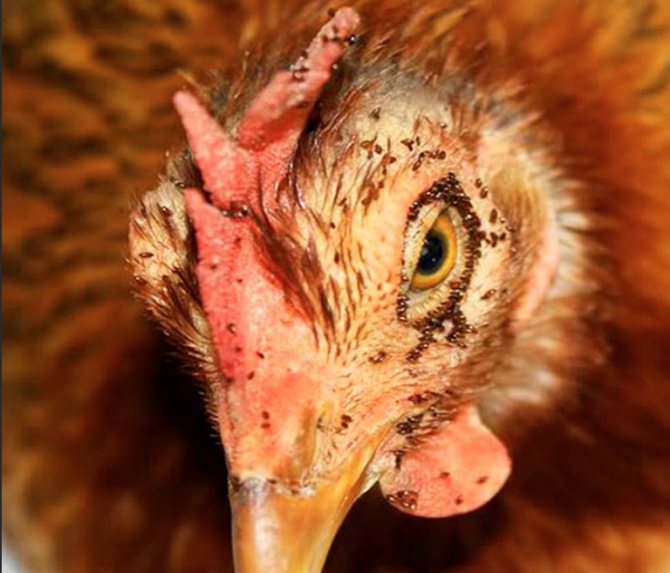

A weakened bird becomes a victim of bacterial infections and helminths, mortality begins.

